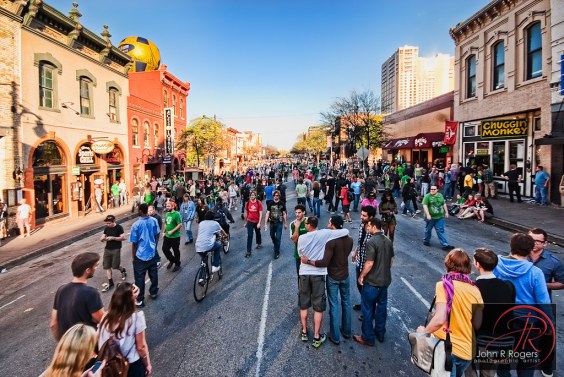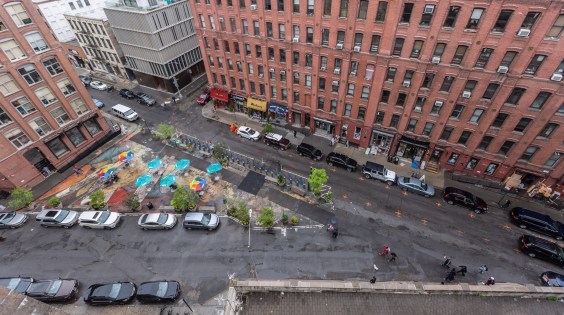 The back door of one of Muni's new low-floor buses. All-door boarding and more low-floor buses could speed up Muni by reducing boarding time. Photo: Michael Rhodes
The back door of one of Muni's new low-floor buses. All-door boarding and more low-floor buses could speed up Muni by reducing boarding time. Photo: Michael RhodesSome of the most important changes for Muni are also the simplest
ones and there are a number of relatively basic adjustments the MTA could make that would improve service and speed up the city's buses.
Much of the debate on improving overall Muni speed revolves around how to move buses through intersections faster or give them priority lanes. It's almost as important, however, to consider how long buses spend not moving: Between 15 and 30 percent of travel time on Muni lines throughout the city is taken up by customers getting on and off the bus.
That's why speeding up boarding is one of the most important things Muni can do to improve service, which we detail at length in our new Streetfilm, the first in a series of five.
Right now, boarding the bus is a slow process, where every passenger must board through the same door. If one person is fumbling for change, it can back up a long line of riders who already have a Fast Pass or other payment ready to go.
Without any major technological upgrades, Muni could switch to a much faster system of boarding. It's called proof-of-payment (also known as POP), and it allows riders to enter through any door on the bus as long as they have a Fast Pass or transfer, or if they tag their TransLink card at the rear card readers.
Switching to proof-of-payment and all-door boarding would require more fare inspectors for the buses, and some relearning of old routines for passengers, but it's hardly a radical idea. In fact, it's already in place on Muni's light-rail vehicles when they're running on the street, where they operate almost identically to buses. Passengers can board through any door -- no need to flash the driver any proof you've paid -- and MTA inspectors make random inspections to stop fare evasion. You still have to pay for a pass at the front of the vehicle, but frequent riders can skip the line and board through other doors.
It works pretty well, too: fare evasion rates are 50 percent lower on Muni's light rail vehicles than they are on the buses.
Muni's longest buses are similar to the light rail vehicles in that they have more than two doors. Riders seem to already grasp the similarity: many board through rear doors even now, though it's still illegal. While that has inspired a lot of frustration from riders who don't appreciate freeloaders, the reality is that many back-door boarders -- about 45 percent, according to an MTA study [PDF] -- do have valid fares, and if Muni were to crack down on all back-door boarding, it would likely seriously impact boarding speeds. An "immediate shift to exclusive front-door boarding could result in longer times at stops and slower travel times," that same study notes.
At present, Muni has the highest rate of bus boardings per hour in the country, at 70 per hour, beating out New York by a nose. By switching to all-door boarding, that rate could go even higher, at significant benefit to Muni's speed.
Proof-of-payment and all-door boarding are common in Europe, but the MTA can also look to a closer-to-home example in Ottawa, Canada. Like Muni's LRVs,
customers board in front if they still need to pay their fare, and
everyone must be able to present valid proof-of-payment to fare
inspectors at any time. Several U.S. bus rapid transit lines include proof-of-payment already as well, including Cleveland's HealthLine and Los Angeles' Metro Orange Line.
But all-door boarding isn't the only solution. Ideally, major stops would have ticket vending machines, allowing riders who don't have a monthly Fast Pass to pay their fare without holding up the bus. An example of this already exists for the light rail vehicles at the 4th and King Caltrain station, but it has yet to roll out for any bus stops.
"We're currently researching different options for our ticket vending machines," said Julie Kirschbaum, Project Manager for the MTA's Transit Effectiveness Project. "The equipment that we have now is very expensive to maintain, which is why we're also researching things like the TransLink Add Payment machines, because those can be easier to maintain. We're currently working on getting more of them in at light rail stations and eventually on the surface as well."
In the long term, the MTA also hopes to switch over its entire Muni fleet to low-floor buses. With bus floors that are nearly flush with the curb, they're much quicker and easier for all passengers to board, but especially those who are mobility-impaired. Muni has about 80 of these vehicles now, out of a total bus fleet of over 900.
Converting the whole bus fleet to low-floor vehicles will take a while. Switching to proof-of-payment and all-door boarding could happen much sooner, but not happen overnight -- the MTA needs to retrain operators and
riders, and hire enough fare inspectors to cover its buses as well. The agency hasn't offered a time frame for switching yet, perhaps because staff members are tied-up dealing with the current budget crisis and service cuts, but it could be done relatively quickly, with great benefit to its riders and maybe even its budget.




